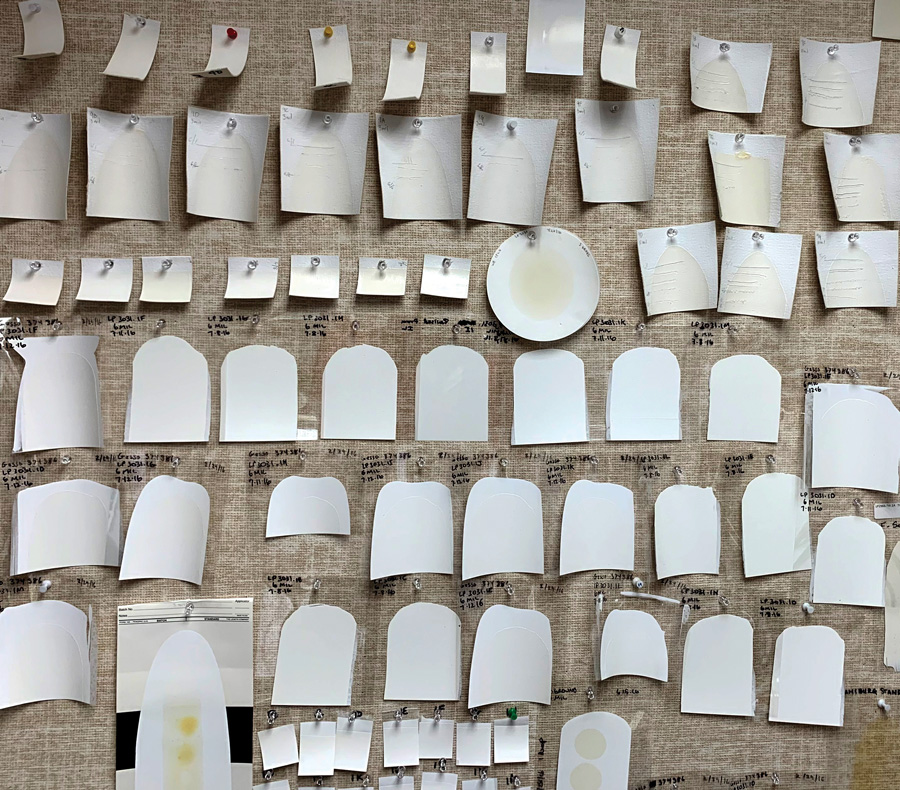
You would think that we would know more by now; that the questions would be answered, the arguments settled. But we don’t, and they aren’t. Even basic and fundamental issues continue to remain unaddressed by research. Will cold-pressed or alkali-refined linseed oil yellow more? Do historical and traditional processing methods lessen that? How do all of these compare to poppy and walnut and safflower? Does adding drier help or hurt? And what about the other ingredients that find their way into paint recipes? Or is a more purist approach better? What follows will not answer any of those things; certainly not in any satisfying and definitive way. But it’s a start, and we want to share our research as it unfolds. And that means many results will be provisional, even provocative, and will need time to settle into something that feels like surety. Long before and alongside our efforts, many of you conduct and share your own tests, write blogs and post in forums, take workshops and classes, all with the hope of figuring this stuff out. What we can add to the mix is the value of results drawn from standardized, controlled and long term testing, focused around similar questions and driven by a similar curiosity.
Causes of Yellowing
It is surprising how little we have been able to narrow down the causes of yellowing. This is especially true given how old the issue is. Right from the get-go, from the earliest days of oil painting, it was front and center one of the problems to solve. But over all this time, the likely suspects have only seemed to multiply. Humidity, temperature, the amount and type of light, periods of darkness, exposure to chemicals, the pigments used, the type of oil and the method of processing it, presence of impurities, the thickness of the paint, use or lack of driers, added mediums, differences in formulations, and a host of other variables, all appear to play a role. This makes any research on the yellowing of oils a daunting task, especially as the variables are not simply the physical make-up of the paints and pigments, but all the usual environmental factors that need to be controlled. And the present studies are no exception. What follows does not attempt to solve or lend support to a particular theory. Rather it simply shares our empirical findings from a multitude of tests that have been ongoing since 2010, when we first acquired Williamsburg Handmade Oils. In terms of age, the examples run from just under 9 years old up to ones that are currently 2.5 years. Collectively all of these would still be considered very young films, still in the first stages of the processes and changes that will continue for centuries.
Which Oils We Tested
We tested 14 oils in all, representing a wide range of the common ones available from different oil and paint companies, as well as more unusual options. They included 3 Alkali-Refined (ARLO) and 4 Cold-Pressed Linseed Oils (CPLO), a fifth CPLO labeled as ‘Bleached’, a water-white almost 20 year old ARLO that was kept in a sealed jar near a window, 2 additional CPLOs that were water-washed and hand-processed following historical methods, and finally a Poppy, Safflower, and Walnut oil. The oils were tested by themselves, as well as being made into a series of Titanium White paints. In that part of the testing, we followed two different approaches. In one, we created a basic, representative formula for Titanium White and simply changed the oil being used, making minor adjustments when needed to keep the thickness of the paint the same. We created a second series where the same oil and pigment were blended with different components, as a way to gauge the impact of each ingredient, moving from a simple combination of just pigment and oil all the way to a fuller and more complex formulation.
The Yellowing of Oil Alone
This area of our research held few surprises at the broadest level: poppy yellowed least, followed closely by safflower and walnut, and behind them a large grouping of linseed oils showing only the slightest variations among themselves. And perhaps just that sense of sameness was the most noteworthy and compelling feature; like most, we went into this expecting to see a clearer difference between alkali-refined, cold-pressed, and the traditionally water-washed versions. In fact, that was the initial hypothesis we wanted to document when we started these trials.
We tested oils in several ways and at various thicknesses. In one test we applied them to glass slides that were frosted, as well as ones having a small concave depression or well where we placed either one or three drops of oil. We also applied three drops to large disks of Whatman® filter paper, allowing the oil to spread outward in a uniform manner. All samples were then kept under ambient conditions, exposed to alternating cycles of 12 hrs. of darkness and full spectrum fluorescent lights. Nearly every sample was prepared in triplicate and no variance was noted in the results.
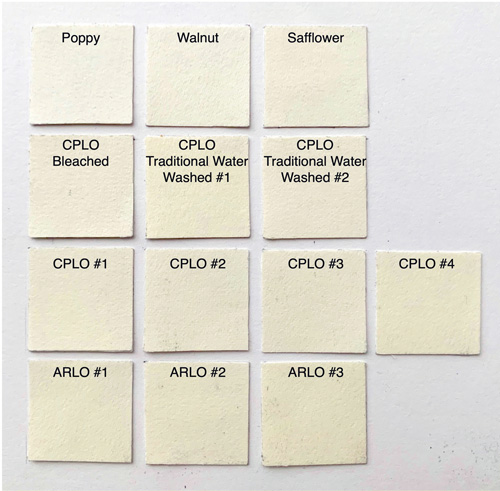
As one can see, the results on the filter paper are tightly grouped. While the poppy oil is indeed lighter, followed by walnut and safflower, all the other examples tended to be indistinguishable (Image 1). Separately, the glass slides showed similar results, although the larger volumes of oil did seem to generate slightly more variance in color, while oils like poppy and walnut displayed far less surface wrinkling, likely due to slower drying times delaying the formation of surface skin. Very thin films on frosted slides, on the other hand, appeared nearly identical across all samples and displayed such a small degree of color they appear essentially clear (Image 2).
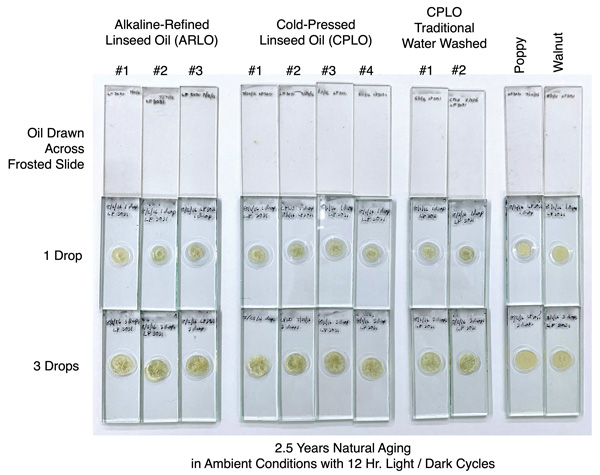
This difference between thick and thin films is something we also noticed in other testing, where 3 mil films of oil (about the thickness of a sheet of paper) were drawn down on top of acrylic gesso. In the example we show (Image 3) of an alkali-refined linseed oil, cast in 2014 and later kept pinned to a wall in an office, the very thin area has just the slightest tint of color, while the oil that spread and gathered off to the right side, culminating in a 9 mil area towards the top, took on an increasingly amber tone. Whether the drops of oil on the slides will develop along similar lines over the next 4-5 years remains to be seen.
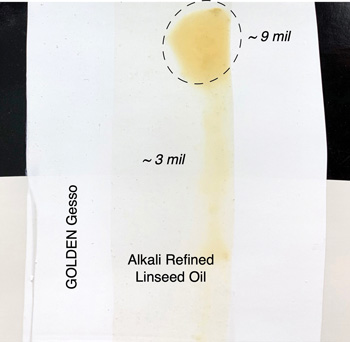
This dichotomy between thin and thicker films of oil makes it problematic to hang too much weight on examples of yellowing where the oil has pooled and formed a solid mass, like one can sometimes find around the neck of an old tube of paint. While these can be dramatic and raise alarm, it is also true that it is never advisable to use oil in this way. Even in glazing, where mediums start to play a dominant role, the applications should always be kept as thin and lean as possible to limit any yellowing. This also holds true when working with thickened oil or alkyd-based impasto and extender mediums, where it can be tempting to create thick translucent textures that can unfortunately yellow dramatically and irreversibly over time.
From Oils to Paint
If the oils themselves felt close in appearance, things became even tighter once they were made into batches of Titanium White. After 2.5 years, what differences you can tease out are subtle at best, and the overwhelming feeling is one of similarity. In fact, the differences are so small that the inherent limitations of screens and printed pages have made capturing them reliably in a photo next to impossible (Image 4). In the end, the hoped for evidence that this or that oil causes the whites to yellow markedly more than another simply never materialized. Rather the dictum that eventually, ultimately, most oils converge toward a similar appearance would seem the better fit for what we eventually found; at least given the test conditions and time frame. Further aging might still crown a clear winner, and other factors besides the oil alone might prove to have the more lasting and decisive impact.
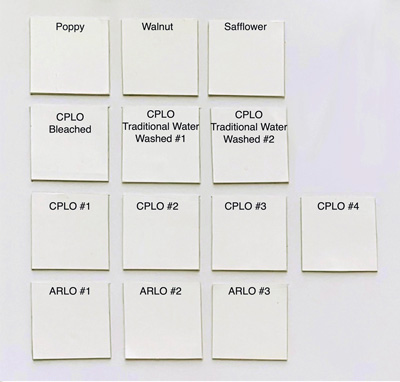
You can see this convergence taking place over time by using a spectrophotometer to measure the initial yellowness of the paints fresh from the tube and following them as they dry and age. In the graph (Figure 1) you can see that the paints have their greatest differences right at the start. After just one day most of the paints actually became whiter, and by the end of the week, when they had all dried to the touch, their differences began to flatten out. From there to their current state at 2.5 years is simply a slow drift upwards to an almost identical degree of yellowness among each of them. For a point of reference and comparison, we have also included the data from GOLDEN Acrylic Heavy Body Titanium White. The importance here is not simply to highlight the difference between the two mediums, but because the brightness inherent in white acrylic paints and gessos have set a standard that we often judge things against.
Finally, before one is tempted to read too much into the pecking order of the paints, the amount of difference between the first and last oil paint is just a single point, or Delta E (▲E) of 1, an amount considered just-perceptible for most people. Also, keep in mind that the b* scale runs from 0-100, while the graph zooms in from 0-10, allowing you to see the subtle movements that are happening. However this can also end up magnifying our sense of just how much difference you might actually notice if you saw these swatches, especially if separated by some space or in the context of different paintings.
If anything stands out as remarkable, it is perhaps the overall sameness that we noted when looking at just the oils – the different brands of alkali-refined, bleached, or cold pressed linseed, as well as traditionally cleaned and water washed ones, in the end all simply crowded close together. Does this mean that all the passions spent advocating for one or another of these variations are simply much ado about nothing? That all the claims of decreased yellowing might not matter all that much in the end? Perhaps. Or this could simply be the usual bunching-up that one sees at the start of any long distance race. We are barely out of the blocks after all, and patience is called for. Still, these results defy most expectations and stand in contrast to other panels of various whites that even we have created. That said, these are still the first large set of controlled examples that we know of, compromised of some 90 swatches all made to a similar formula and kept under the same conditions, where only the type of oil changes. We will ultimately go wherever the evidence leads, while still looking to confirm these findings in future rounds.
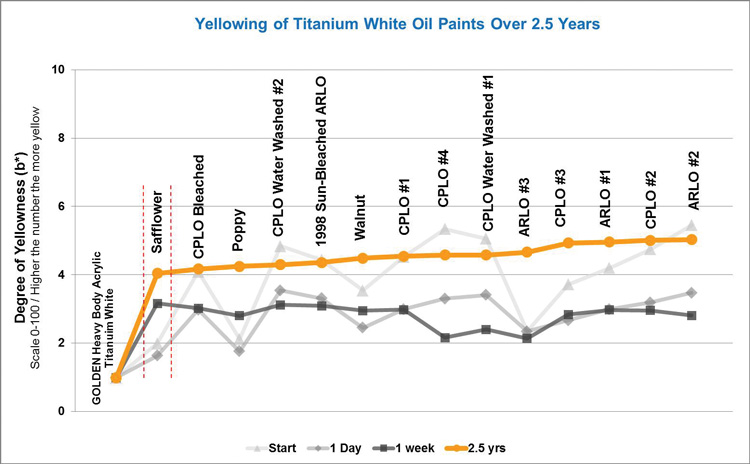
Impact of Formulation on Yellowing
This is an area that has remained largely unstudied in any systematic way. Research on oils in and of themselves, as well as treated by various methods, are easier to find, along with ones that blend oils with single pigments and perhaps some drier. Absent in all those are studies that take a look at the impact of all the various components that make up most modern oil paints. Our own work in this area dates back to 2010, when we acquired Williamsburg Handmade Oil Colors, and some results start to come in that are interesting to look at.
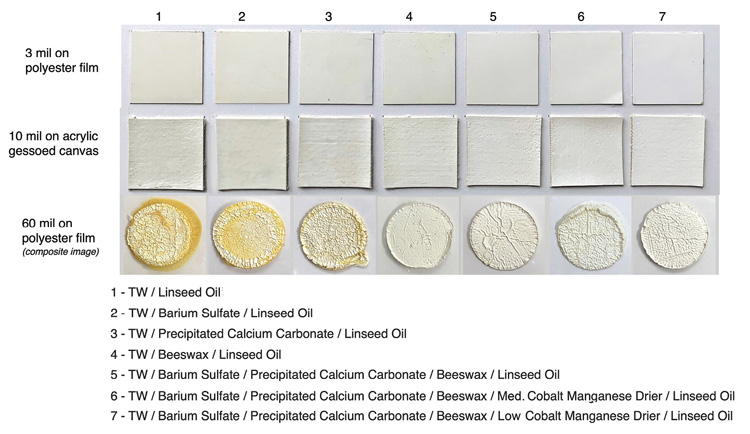
In the assembled examples (Image 5), the paint made with just Titanium White and alkali-refined linseed oil yellowed the most, belying the common belief that simple blends of pigment and oil are always the best. Perhaps even more significant is what happened when this paint was applied in a thicker, 60 mil (~1/16”) application, where you see a dramatic level of oil separation during the drying process. The next two variations, which include the addition of barium sulfate or precipitated calcium carbonate, become increasingly less yellow while also showing a corresponding drop in oil exuding to the surface or out the sides. This sets up a strong correlation between yellowing, at least with Titanium White, and the paint’s ability to fully bind and hold onto the oil and prevent it from seeping out. This would also explain why the paints become significantly whiter, especially in the thick application, once beeswax was added in as a stabilizer, or why the addition of drier on top of that would help even further. The beneficial effects of drier in this regard is noteworthy as far too often it is claimed that their use leads to more yellowing, not less. This is the opposite of everything we have observed. However, these tests do not include the full range of available drier combinations, their use in distinctly different paint formulas, under different environmental conditions, or at levels that would be considered excessive.
While the pressing-out of oil is dramatically captured in the 60 mil disks, it is worth speculating that a similar but much smaller-scale process could be happening in the thinner swatches as well – namely that oil is rising to the surface at a microscopic level, and forming a thin, yellowed film around the topmost layer of pigment. This phenomenon around the formation of a skin of medium on top of the paint has been noted by current researchers of modern oil paints, although the exact cause has not been established (Izzo, F.C., et al, 2014; Burnstock, A. et al, 2014; Cooper, A. et al, 2014). We also know that this type of phenomenon is one of the main reasons that Zinc Oxide was used so frequently in conjunction with titanium dioxide. Essentially Zinc Oxide’s rapid ability to form metallic soaps and create a laminar, crystalline structure, appear to help hold the oil in place, although at the cost of creating a brittle paint film, especially at higher levels. The combination of beeswax and drier used in these tests might be helping along similar lines, but without the downsides with zinc.
Dark Yellowing
Dark yellowing is a well-known phenomenon where oil-based paints stored in the dark will yellow significantly, although the yellowing is thought to be fully reversible by exposing the paints to light (Levinson,H., 1965; Townsend, J.2011). This is an area we have written about before (Sands, S., 2014, 2017) but never comparing the rate and extent of recovery based on simple pigment/oil mixtures alongside a more fully formulated paint. Having a selection of swatches kept in dark storage for around 6 years, and examples of the same formulas kept in ambient, indoor light for 3 months and another set for 2.5 years, has led to some interesting results (Image 6).

Differences in yellowing could be found in all three stages. Of the swatches kept in the dark, the one made with cold-pressed linseed did the worst, followed closely by alkali-refined, then safflower and the others. The paint made with just pigment and stand oil did the best in this category, although it should be noted the paint itself was unpleasant to work with because the oil was so viscous. The fully formulated paint did far better than the same pigment mixed with just ARLO or CPLO, and in the end nearly equaled the paints made with safflower or that included zinc in the mix. It is also critical to note just how long it took these paints to recover from long-term dark storage when exposed to just typical indoor light levels. After 3 months the recovery was still only partial when compared to similar examples in the same room for 2.5 years. Thus the time needed to fully reverse the effect of dark yellowing can take far longer than many people might realize. Needing this type of long recovery period has also been noted in more recent conservation research (Townsend, D., et al, 2011) where the required period for pieces kept in prolonged dark storage was thought to extend to multiple years in gallery lit conditions.
The Making of the White Paints Used in the Tests
For testing of the 14 different whites, each of the paints was made using a basic formula of oil, titanium dioxide, synthetic precipitated calcium carbonate, barium sulfate, beeswax and a low level of cobalt-manganese drier. These were then cast directly onto polyester film that was either uncoated or had a layer of acrylic gesso applied as a ground. We used polyester because it is non-reactive and stable, while the addition of acrylic gesso simulates some of the absorbency one gets when painting on a typically primed canvas. The samples were then stored under ambient conditions with light coming from color corrected fluorescent bulbs on a 12 hr. light/dark cycle, or else in an office with similar fluorescent lighting supplemented with indirect window light. They have not undergone any prolonged dark storage.
Things Not Tested
In any test, what is left out can be as important as what is included. We did not control for humidity or temperature, two environmental factors commonly linked to increased yellowing. No mediums were included. The driers were limited to either a low or medium level of a single cobalt-manganese combo, and a host of other potential modifiers and additives were left out, such as hydrogenated castor wax, magnesium carbonate, and aluminum stearate. The range of substrates and grounds were also very limited, and we mainly cast the paints onto polyester film that was either coated with GOLDEN Acrylic Gesso or left plain, although one set of examples were applied to acrylic gessoed canvas. In terms of pigment, we tested only one type of rutile titanium dioxide, supplemented by zinc oxide in two examples, but did not test basic lead carbonate, lithopone, or zinc oxide by itself. Finally, we did not include other brands of paint for comparison since we had no way of knowing their exact ingredients, and therefore no way to know what might be responsible for any results in either direction.
Conclusion
At the moment, none of this testing will definitively resolve which oil or formula of Titanium White will yellow the least. But at least it starts to give us a controlled set of paints kept under controlled conditions that can form one basis of the discussion. More rounds of testing using fresh drawdowns of yet more variations, are in the works and as those results come in, and these original swatches continue to age, we will certainly publish and share those findings. This is work and research that will literally go on for decades, long past the lives of most of us in the Lab. The hope is that in the future, when all those questions about oils and yellowing continue to be asked, that the answers will have a firmer footing.
References
Burnstock, A, van den Berg, K.J.,“Twentieth Century Oil Paint. The Interface Between Science and Conservation and the Challenges for Modern Oil Paint Research”, In: van den Berg K. et al. (eds) Issues in Contemporary Oil Paint. 2014, Springer, Pages 1-20
Cooper, A.,Burnstock, A., van den Berg, K.J., Ormsby, B. “Water Sensitive Oil Paints in the Twentieth Century: A Study of the Distribution of Water-Soluble Degradation Products in Modern Oil Paint Films”, In: van den Berg K. et al. (eds) Issues in Contemporary Oil Paint. 2014, Springer, Pages 294-310
Izzo F.C., van den Berg K.J., van Keulen H., Ferriani B., Zendri E. “Modern Oil Paints – Formulations, Organic Additives and Degradation: Some Case Studies” In: van den Berg K. et al. (eds) Issues in Contemporary Oil Paint. 2014, Springer, Pages 75-104
Levison, Henry, “Yellowing and Bleaching of Paint Films”, Journal of the American Institute for Conservation, Vol. 24, No. 2 (Spring, 1985), pp.69-76
Sands, Sarah, “What is Dark Yellowing?”, Just Paint, Golden Artist Colors, August, 2017, www.justpaint.org/what-is-dark-yellowing/
Sands, Sarah, “Williamsburg’s New Safflower Colors”, Just Paint, Golden Artist Colors, Issue 30, February, 2014, www.justpaint.org/williamsburgs-new-safflower-colors/
Townsend, J., Carlyle, L., Cho, J.H., Campos, M.F., “The yellowing/bleaching behaviour of oil paint: further investigations into significant colour change in response to dark storage followed by light exposure”, ICOM-CC, 16th Triennial Conference, Lisbon, 19-23 September 2011. p. 1-10
About Sarah Sands
View all posts by Sarah Sands -->Subscribe
Subscribe to the newsletter today!
No related Post
